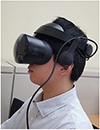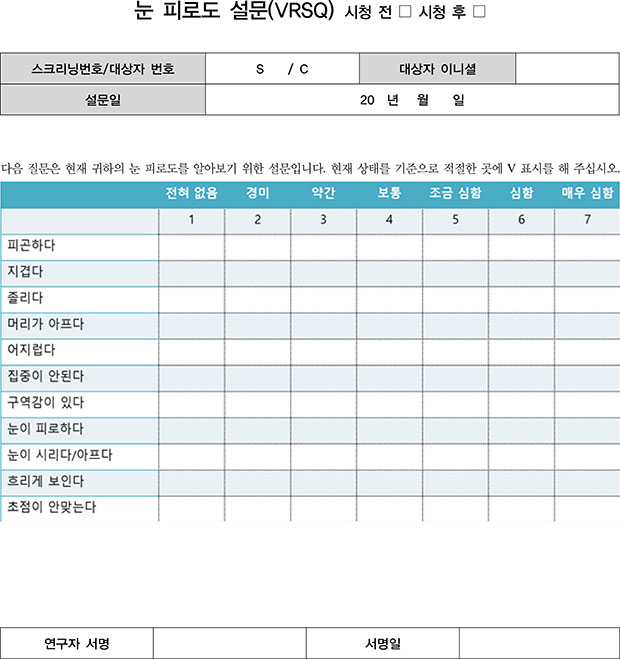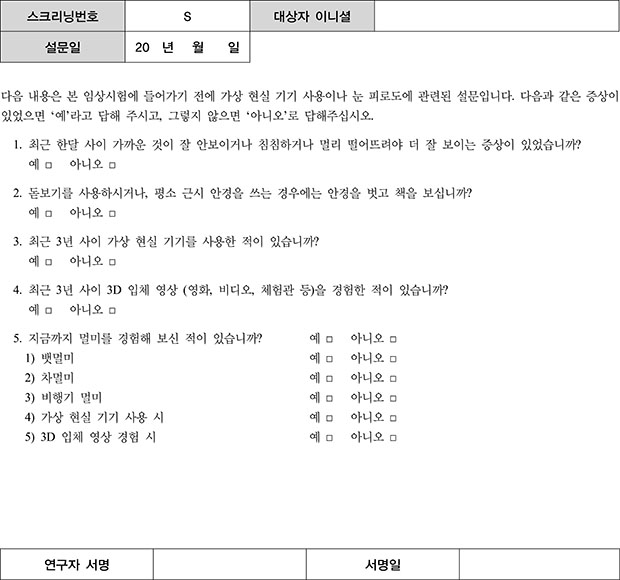Abstract
Purpose
To investigate ocular fatigue after the use of a head-mounted display (HMD)-type virtual reality device.
Methods
Healthy adult volunteers were examined for ocular fatigue before and after watching videos for 10 min with an HMD-type virtual reality device. Subjective ocular fatigue was measured using a questionnaire. Objective fatigue was measured using the critical flicker fusion frequency (CFF), high frequency component of accommodative microfluctuation, and accommodation amplitude. The accommodation amplitude was measured using the push-up method and the dynamic measurement mode of the autorefractometer. Changes in the spherical equivalent were also measured.
Results
The questionnaire-based subjective ocular fatigue increased (p = 0.020) after use of the HMD device. In the dominant eye, the high frequency component of accommodative microfluctuation increased (p < 0.05). The accommodation amplitude using the push-up method was decreased in the nondominant eye (p = 0.007), and temporary myopia was observed (p < 0.05). However, there was no increase in ocular fatigue in the CFF or the accommodation amplitude using the dynamic measurement mode, which showed no significant difference before and after using the HMD device (p > 0.05).
Conclusions
A subjective test and some objective tests suggested that use of the HMD-type virtual reality display increased ocular fatigue. However, no increase in ocular fatigue was measured using CFF nor in the accommodation amplitude using the dynamic measurement mode which was a limitation of the study. More studies with the aim to alleviate ocular fatigue after using HMD-type virtual reality devices are therefore needed.
Figures and Tables
Figure 1
Head mounted display (HMD) based virtual reality (VR) display (XQ800ZAA-HC1KR, Samsung Electronics, Yongin, Korea). Subjects watched video for 10 minutes with VR device.

Figure 2
Measurement report of auto refractormeter (Speedy-i, Right MfgCo., Tokyo, Japan). The horizontal axis of the graph represents target distance and vertical axis of the graph represents accommodation responses.

Figure 3
Flicker fusion frequency tester (Model 12021A, Lafayette Instrument Company, Lafayette, IN, USA). It can measure threshold frequency where a flickering light is perceived as continuous, defined as the critical flicker fusion frequency.

Figure 4
Auto refractormeter (WAM-5500 Grand Seiko, Hiroshima, Japan). Objective refraction was measured under single viewing conditions. Moving target stimulate accommodation and auto refractormeter measure amplitude of accommodation dynamically.

Table 3
The changes of factors associated with ocular fatigue before and after watching virtual reality device

Table 4
The difference of subjective amplitude of accommodation with push up method and objective amplitude of accommodation with autorefractormeter

Table 5
Questionnaire about presbyopia, experience of virtual reality device, 3D stereoscopic video, sickness

References
1. Kwon J, Kang SY, Kim KH, et al. The ocular fatigue of watching three-dimensional (3d) images. J Korean Ophthalmol Soc. 2012; 53:941–946.

2. Song EJ, Jung A. A study for reducing of cyber sickness on virtual reality. J DCS. 2017; 18:429–434.
3. Sharples S, Cobb S, Moody A, Wilson JR. Virtual reality induced symptoms and effects (VRISE): Comparison of head mounted display (HMD), desktop and projection display systems. Displays. 2008; 29:58–69.

4. Wehr F, Held J. Stereoscopic versus monoscopic displays: learning fine manual dexterity skills using a microsurgical task simulator. Appli Ergon. 2019; 77:40–49.

5. Lambooij M, Fortuin M, Heynderickx I, IJsselsteijn W. Visual discomfort and visual fatigue of stereoscopic displays: a review. J Imaging Sci Techn. 2009; 53:30201.

6. Cho KJ, Kim SY, Yang SW. The refractive errors of dominant and non-dominant eyes. J Korean Ophthalmol Soc. 2009; 50:275–279.

8. Rice ML, Leske DA, Smestad CE, Holmes JM. Results of ocular dominance testing depend on assessment method. J AAPOS. 2008; 12:365–369.



9. Ames SL, Wolffsohn JS, McBrien NA. The development of a symptom questionnaire for assessing virtual reality viewing using a head-mounted display. Optom Vis Sci. 2005; 82:168–176.


10. Kajita M, Ono M, Suzuki S, Kato K. Accommodative microfluctuation in asthenopia caused by accommodative spasm. Fukushima J Med Sci. 2001; 47:13–20.


11. Charman W, Heron G. Fluctuations in accommodation: a review. Ophthalmic Physiol Opt. 1988; 8:153–164.


12. Nakatsuka C, Hasebe S, Nonaka F, Ohtsuki H. Accommodative lag under habitual seeing conditions: comparison between adult myopes and emmetropes. Jpn J Ophthalmol. 2003; 47:291–298.


13. Park SM, Lee HM. Objective evaluation of asthenopia using accommodative microfluctuation in the high-frequency region. J Korean Ophthalmol Soc. 2018; 23:477–484.

14. Ju LH, Lee DH, Lee DH, Kim JH. The relationship between the high-frequency component of accommodative microfluctuation, accommodative lag and accommodative amplitude in presbyopic eyes. J Korean Ophthalmol Soc. 2014; 55:1606–1612.

15. Lee WY. A study on driving characteristics of the elderly driver using a driving simulator. J Korean Soc Saf. 2006; 21:103–111.
16. Chen Y, Buhr KA, Hoeve JV. Study of critical flicker fusion (CFF) function and P100 latency of visual evoked potential (VEP) in normal subjects and patients who recovered from acute optic neuritis. Int J Ophthalmol Clin Res. 2017; 4:067.

17. Mitsuhashi T. Measurement and analysis methods for critical flicker frequency and observer fatigue caused by television watching. Electronics & Communications in Japan (Part III: Fundamental Electronic Science. 1995; 78:1–12.
18. Nivetha C, Jagadamba A, Usha GS. Critical fusion frequency a simple non-invasive tool to measure fatigue in granite factory workers. IOSR-JDM. 2016; 15:83–86.
19. Lee HJ, Kim SJ. Factors associated with visual fatigue from curved monitor use: a prospective study of healthy subjects. PLoS One. 2016; 11:e0164022.

20. Gur S, Ron S, Heicklen-Klein A. Objective evaluation of visual fatigue in VDU workers. Occup Med (Lond). 1994; 44:201–204.


21. Thiagarajan P, Ciuffreda KJ. Visual fatigue and accommodative dynamics in asymptomatic individuals. Optom Vis Sci. 2013; 90:57–65.


22. Kang DW, Eom YS, Rhim JW, et al. Evaluation of objective accommodation power in different age groups using an auto accommodation refractometer. J Korean Ophthalmol Soc. 2016; 57:20–24.

23. Kundart J, Tai YC, Hayes JR, et al. Real-time objective measurement of accommodation while reading. J Behav Optom. 2011; 22:130–134.
24. Sharma IP. RAF near point rule for near point of convergence-a short review. Ann Eye Sci. 2017; 2.

25. Guo J, Weng D, Zhang Z, et al. Subjective and objective evaluation of visual fatigue caused by continuous and discontinuous use of HMDs. J Soc Inf Disp. 2019; 27:108–119.

26. Cha KR, Kim CH. Virtual reality in current and future psychiatry. Korean J Biol Psychiatry. 2007; 14:28–41.
27. Kim N, Phan AH, Erdenebat MU, et al. 3D display technology. Disp Imag. 2014; 1:73–95.
28. Turnbull PR, Phillips JR. Ocular effects of virtual reality headset wear in young adults. Scientific Reports. 2017; 7:16172.

30. Yano S, Emoto M, Mitsuhashi T. Two factors in visual fatigue caused by stereoscopic HDTV images. Displays. 2004; 25:141–150.

31. Hoffman DM, Girshick AR, Akeley K, Banks MS. Vergence-accommodation conflicts hinder visual performance and cause visual fatigue. J Vis. 2008; 8:33.


32. Han SJ. Quantitative analysis of display fatigue induced by 2D, 3D videos. J Digit Converg. 2016; 14:329–335.

33. Kim SU, Han SJ, Koo KC. Analysis of display fatigue induced by HMD-based virtual reality bicycle. J Korea Acad Ind Coop Soc. 2017; 18:692–699.
34. Kim J, Sunil Kumar Y, Yoo J, Kwon S. Change of blink rate in viewing virtual reality with HMD. Symmetry. 2018; 10:400.

35. Han J, Bae SH, Suk HJ. Comparison of visual discomfort and visual fatigue between head-mounted display and smartphone. Electron Imaging. 2017; 2017:212–217.

36. Kaido M, Kawashima M, Ishida R, Tsubota K. Severe symptoms of short tear break-up time dry eye are associated with accommodative microfluctuations. Clin Ophthalmol. 2017; 11:861–869.



37. Jeng WD, Ouyang Y, Huang TW, et al. Research of accommodative microfluctuations caused by visual fatigue based on liquid crystal and laser displays. Appl Opt. 2014; 53:H76–H84.

38. Tanahashi M, Miyao M, Sakakibara H, et al. The effect of VDT work on the fluctuations of accommodation. Ind Health. 1986; 24:173–189.


39. Namba T, Tanzawa K, Nakano K, et al. Evaluation of asthenopia caused by game consoles. Kawasaki Journal of Medical Welfare. 2018; 24:9–16.
40. Shim YB, Ko CJ. The study on the near point in Koreans. J Korean Ophthalmol Soc. 1982; 23:627–632.
41. Win-Hall DM, Ostrin LA, Kasthurirangan S, Glasser A. Objective accommodation measurement with the Grand Seiko and Hartinger coincidence refractometer. Optom Vis Sci. 2007; 84:879–887.


42. Wold JE, Hu A, Chen S, Glasser A. Subjective and objective measurement of human accommodative amplitude. J Cataract Refract Surg. 2003; 29:1878–1888.


43. Luberto F, Gobba F, Broglia A. Temporary myopia and subjective symptoms in video display terminal operators. Med Lav. 1989; 80:155–163.

44. Iwasaki T, Tawara A, Miyake N. Reduction of asthenopia related to accommodative relaxation by means of far point stimuli. Acta Ophthalmol Scand. 2005; 83:81–88.


45. Hepsen IF, Evereklioglu C, Bayramlar H. The effect of reading and near-work on the development of myopia in emmetropic boys: a prospective, controlled, three-year follow-up study. Vision Res. 2001; 41:2511–2520.


46. Huang HM, Chang DS, Wu PC. The association between near work activities and myopia in children-a systematic review and meta-analysis. PLoS One. 2015; 10:e0140419.





 PDF
PDF ePub
ePub Citation
Citation Print
Print








 XML Download
XML Download